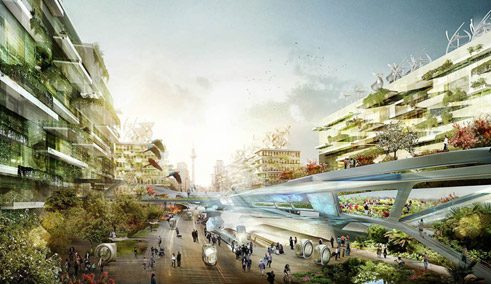Smart Cities
Who will build the city of tomorrow?

Up to now the concept of the “smart city” has generated attention mainly through Asian mega-projects. But in Germany too the idea is playing an increasingly important role.
The fate of humanity lies in the city. More than 50 per cent of the world’s population already lives in urban centres; by 2050 it will be at least 70 per cent. There the bulk of energy and greenhouse gases are consumed and emitted. The future development of cities will therefore exercise a great influence on the environment. This has been recognized by science, politics and industry, and they are working on finding a solution to the associated problems. The solution could be the smart city, also called the city of the future, the city of tomorrow and the eco-city.
“Mobile, safe and sustainable”
At the Federal Ministry for Education and Research (BMBF) smart cities are called “CO2 neutral, energy and resource-efficient, climate-adapted cities of tomorrow”. Together with the initiative Science in Dialogue, the BMBF has for a long time now organized “Science Years”. The Science Year 2015 is dedicated entirely to the city of the future. The theme year aims at providing better information and networking for citizens, scientists and municipalities, with the goal of making research more transparent. According to a definition of the smart city by the Fraunhofer Society, it is an “informed, networked, mobile, safe and sustainable city”.The future is nigh
The clever city can do a great deal: intelligent guidance systems regulate traffic, energy information networks transport energy and in the best case reduce its consumption. With the help of intelligent information and communication technologies, all important areas of life such transport, administration, health, housing, education and culture can be networked and controlled. The smart new world, in which there is a technological solution for everything, is, according to the Fraunhofer Society, ”closer than you think”.And in fact the cities of the future have long been abuilding. A spectacular example is the South Korean project of New Songdo City, whose foundation stone was laid in 2003 and where today more than 20,000 people live. Or Fujisawa Sustainable Smart Town: a model settlement in the outskirts of Tokyo, comprising about 1,000 households. In Europe it is more about the implementation of smart city elements in already existing cities. Amsterdam Smart City or Smart City Vienna are the names of corresponding projects.
Telekom City – a German project
The hitherto most comprehensive German smart city project is Telekom City Friedrichshafen. Initially for five and then for a further three years, smart city applications in administration (“e-government”), traffic (“e-ticketing”) and networked homes were tested in the city in the federal state of Baden-Württemberg. The project, completed in February 2015, was to show the plus generated by innovative information and communication technologies.Urban researchers at the Geographical Institute of Bonn University, which accompanied the project, came to a positive conclusion. The city of Friedrichshafen and German Telecom also stated that they had learned much in the course of the project. But the desired broad participation and enthusiasm of the population, as another statement said, had “not materialized”. And “For many citizens the subject remained too abstract”.
Criticism of the smart city
It is big companies that have long been pushing smart cities. The technological development of New Songdo City is in the hands of Cisco, and Fujisawa Sustainable Smart Town is being built by a consortium of 18 companies led by Panasonic. The German technology group Siemens, among others, is taking part in the building of the eco-city of Masdar in the United Arab Emirates. And even on EU smart city committees, which decide on EU guidelines and funding, sit company representatives.This is one of the principal criticisms of Christoph Laimer, Chairman of the Vienna Association for Urban Research Derive and chief editor of the eponymous magazine. For him and other critics, almost all smart city projects are not about the interests of citizens. Smart cities, Laimer argues, are centralized top-down projects led by corporations, which put municipalities under pressure and in which citizens appear at best as consumers. He calls for a public, “objective discussion of the currently most dominant planning vision for the future of our cities”.